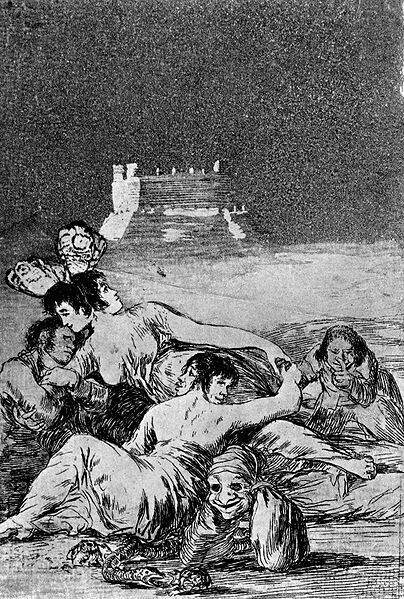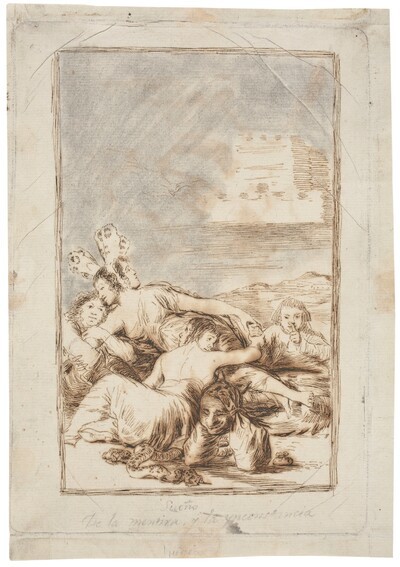- Cronología
- Ca. 1797 - 1798
- Ubicación
- Biblioteca Nacional, Madrid, España, Madrid, Spain
- Dimensiones
- 200 x 132 mm
- Técnica y soporte
- Aguafuerte y aguatinta bruñida sobre papel verjurado
- Reconocimiento de la autoría de Goya
- Documented work
- Titular
- © Biblioteca Nacional de España
- Ficha: realización/revisión
- 20 Jan 2011 / 21 Jun 2023
- Inventario
- INVENT/45637
See Francisco de Goya y Lucientes, Painter.
This is a unique unpublished proof that belonged to the former Carderera collection in 1867 and later passed to the National Library in Madrid.
The title of this engraving is taken from the preparatory drawing in the Prado Museum.
A figure on the left-hand side of the engraving, with a mournful expression, clutches the arm of a woman standing next to him across his chest. The woman has a double face, on the one hand looking at the man holding her arm and on the other facing towards the background, with butterfly wings on her head. It extends its other arm, shaking hands with a figure reclining in the foreground with his back to the viewer. We cannot tell whether it is a man or a woman, as it is a rather ambiguous figure with a broad back and an undefined double face, although she wears a skirt and high heels. Next to it, Goya has made a grotesque, smiling mask resting on two saddlebags. Next to the mask, a snake is attacking a toad, while another batrachian bites the snake on the back. On the right-hand side of the engraving, we can see a crouching figure advancing and holding a finger to his mouth as a sign of silence. All this is taking place in a misty landscape in the centre of which stands a castle with turrets and battlements.
This engraving is extremely complex and various explanations have been offered for it, although most specialists believe that it could be a veiled allusion to the relationship the Aragonese painter had with the Duchess of Alba while he was in Sanlúcar. The aristocrat would therefore be the double-faced woman with a butterfly on her head who is being clutched in anguish by Goya. She had already been depicted with butterflies on her head in print no. 61 of the series entitled Volaverunt.
It is possible that the Aragonese painter had turned to the Iconology of Cesare Ripa (Perugia, 1555-Rome?, 1622) for a visual source to inspire the two double-faced figures. This detail would allude to the false nature of the figures, while the butterflies on the woman's head could be a reference to the evanescence of emotions, to the superficiality with which this figure confronts his own feelings. The snake and the toads are symbols of lowliness and the castle in the background an image of love illuminated by moonlight. The saddlebags on the mask are related to the expression, "to pass to the other saddlebag", which means to deceive. In addition, the figure making a gesture of silence on the right side of the print could be indicating the clandestinity that defines the situation that Goya has allegorically narrated in this engraving.
According to Nigel Glendinning, this print may refer to Manuel Godoy's love affairs with María Luisa of Parma and Pepita Tudó, who was his mistress from 1800 and whom he married after his wife's death in 1828.
Perhaps Goya decided not to publish this engraving because of the important critical content that could be unravelled and provoke some kind of reaction that would compromise him. It could also be thought that what he was narrating was too personal and perhaps too painful for him to expose publicly, so he decided to withdraw it.
The sheet is trimmed, creased and dirty. Stamper's fingerprints appear on the lower edge of the sheet.
-
Grabados y dibujos de Goya en la Biblioteca NacionalBiblioteca NacionalMadrid1946catalogue Elena Páez Ríosp.26, cat. 55
-
Goya: zeichnungen, radierungen, lithographienInternational TageIngelheim1966exhibition displayed from May 7th to June 5 th 1966cat. 77
-
The Changing Image: Prints by GoyaMuseum of Fine ArtsBoston1974From October to December 1974. Exhibited also at The National Gallery of Canada, Ottawa, January to March 1975p.121, cat. 92
-
Goya en la Biblioteca Nacional. Exposición de grabados y dibujos en el sesquicentenario de su muerteBiblioteca NacionalMadrid1978May - June 1978p.36, cat. 57
-
Goya (1746-1828). Peintures-Dessins-GravuresCentre Cultural du MaraisParís1979consultant editors Jacqueline et Maurice Guillardcat. 156
-
Goya: Zeichnungen und DruckgraphikStädtische Galerie im Städelschen KunstintitutFrankfurt1981from February 13th to April 5th 1981pp.74-75, cat. D49
-
Goya. La década de Los CaprichosMadrid1992organized by Real Academia de Bellas Artes de San Fernando sponsored by Fundación Central Hispano, Madrid, consultant editor Nigel Glendinnig. From October 26th 1992 to January 10th 1993p.63, cat. 39
-
Goya grabadorFundación Juan MarchMadrid1994consultant editors Alfonso E. Pérez Sánchez and Julián Gállego, from January 14th to March 20th 1994p.111, cat. 4
-
Ydioma universal: Goya en la Biblioteca NacionalBiblioteca NacionalMadrid1996from September 19th to December 15th 1996p.150, cat. 119B
-
Goya: Order and disorderMuseum of Fine ArtsBoston2014cat. 41
-
Les Caprices de GoyaParísF. Hazan1948s/p
-
Los Caprichos de Goya y sus dibujos preparatoriosBarcelonaInstituto Amatller de Arte Hispánico1949s/p
-
El sueño de la mentira y la inconstanciaGoya, Saturn and Melancholy. Studies in the Art of GoyaStockholmActa Universitatis1962pp.171-183
-
Goya engravings and lithographs, vol. I y II.OxfordBruno Cassirer1964p.162, cat. 119
-
Vie et ouvre de Francisco de GoyaParísOffice du livre1970cat. 619
-
El sueño de la mentira y de la inconstancia’ y sus raíces wattonianasGoyaMadridFundación Lázaro Galdiano1971pp.240-245
-
Imaginación de Goya: nuevas fuentes para algunos de sus dibujos y pinturasMadridCSIC1976pp.284-286
-
Goya and his CriticsNew Heaven-Londres: Yale University Press1977pp.167-168
-
Los Caprichos de Goyacol. Serie punto y líneaBarcelonaGustavo Gili1977p.198-199
-
Goya, la década de los caprichos: dibujos y aguafuertesMadridReal Academia de Bellas Artes de San Fernando1992pp.63-65, cat. 38-39
-
Catálogo de las estampas de Goya en la Biblioteca NacionalMadridMinisterio de Educación y Cultura, Biblioteca Nacional1996p.118, cat. 174
-
El libro de los caprichos: dos siglos de interpretaciones (1799-1999). Catálogo de los dibujos, pruebas de estado, láminas de cobre y estampas de la primera ediciónMadridMuseo Nacional del Prado1999pp.398-401
-
Goya: Order & DisorderBostonMuseum of Fine Arts Boston Publications2014p. 102
-
Goya. In the Norton Simon MuseumPasadenaNorton Simon Museum2016pp. 42-75

